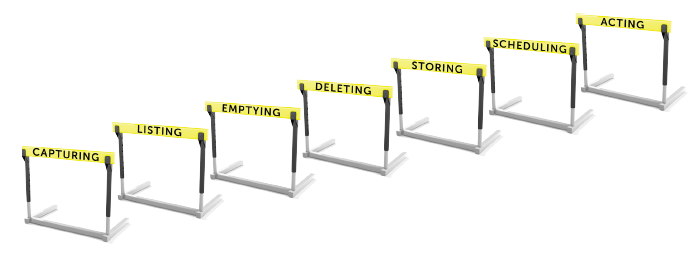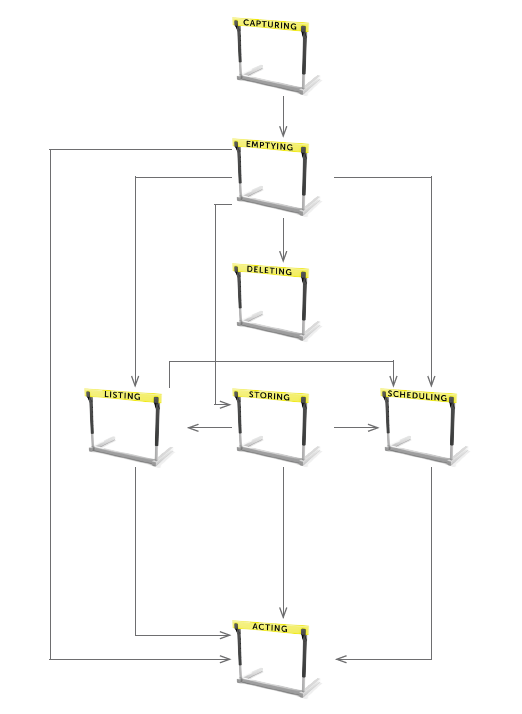I have taught time management for over 14 years. I could argue my training is great. In earnest, it is probably just equal to other good trainers, the main difference being that I teach people to build their own system and to not use mine or the time-management gurus’, because we are all individuals. This led to a breakthrough for me on time management.
Making a Breakthrough in Time Management After Time-Management Training for 14 Years
Recently, I have stumbled on something that is a game changer in time management. It’s not mine. It’s not anyone’s. It feels a bit like how the internet grew: one piece at a time until it all came together.
This information just needed to be brought together. Most time-management tips, lessons and tricks, are about discipline, focus, or small pieces, like writing a daily to-do list, but at the heart of an effective time-management system are seven fundamental game-changing pieces. Get these right and the whole system just works, like the story of the internet.
If you can master these seven pieces, you will significantly upgrade your time-management system. Let’s be positive and call them hurdles, because when you start to jump them, the race to be a better time manager has begun. Find out more about each hurdle below.
To Jump Each Hurdle Is Only One Exercise per Week for 30 Minutes
Jumping these seven hurdles will significantly upgrade your time-management system.
You can’t do part of it. You can’t do one hurdle. You can’t do a bit and come back to it. It’s take the challenge, do the race, or don’t.
My advice? Decide why you are going to spend 30 minutes per week doing these exercises. This is because when you need to “choose left or right” (deciding to do this or do something else), you need a compelling reason why. The answer cannot be “to be a better time manager.” To achieve that goal, find one easy and simple time-management tip on the web, e.g. start each task on your to do list with a verb. Job done. We know from Edwin Locke’s work on goal setting that challenging and specific goals work best.
This goal setting requires some reflection. Decide why. What problem will it solve? Will it help you get home one night on time? Is the goal to be more calm, more in control?
Then the goal is to hear people in the office unprompted saying, “He’s more calm/She seems much more in control.” Write your reason, your goal, on a sheet of paper and keep this close to you. Remember goals need to pack the three Ps, as Muhammad Ali did — “I am the Greatest” — Present, Positive, and Personal. For example, “I am much more in control. People have said so unprompted,” or “I am working on my big projects and my boss has noticed and commented positively to me.”
Now it’s time to take the 7-Week Time-Management Challenge.
Week 1 — Jumping the Capturing Hurdle
How much do you capture of what comes into your world, and into your head?
Jumping the “Capturing” hurdle is about being able to grab any time demand that comes into your world. The more obvious is your email inbox. The less obvious is capturing stuff that you think of when you are driving.
- Using a clean sheet of paper, write ALL the capture points (entry points) of your time-management system that you currently have. For example, email inbox, phone calls, and meetings.
- If you have too many, delete one. For example, you have multiple notepads doing a similar job.
- If you don’t have enough, for example, you are still relying on your memory in the car, in meetings, in corridor conversations, add one.
Week 2 — Jumping the Listing Hurdle
How well do you get things out of your head and onto a list?
Jumping the “Listing” hurdle is about getting stuff out of your head and onto a list. “The most successful people are the ones with the emptiest heads.” Leaving room for thinking, decision making, and problem solving, not for remembering (storage).
- Using a clean sheet of paper, write down ALL the lists that you currently have. For example a daily to-do list.
- If you have too many lists remove one. Particularly the lists that you do not trust. For example, the Outlook reminders list.
- If you don’t have all of the following lists, add one; particularly the daily to do list (not a stream of actions), or the call list, project list, waiting for list, weekly list, monthly list, or a some day maybe list.
Week 3 — Jumping the Emptying Hurdle
How good you are at emptying those capture points?
Jumping the “Emptying” hurdle is a little like emptying the dishwasher. If you don’t, then it just builds up until you cannot see the dishes for the kitchen sink and then you have to load the dishwasher and wash-up what’s left. Emptying frequently and appropriately is key.
- Using your list of “Capture Points” that you created in Week 1 decide when you will empty each one of your capture points. Add a column two. For example your email inbox will be assessed once an hour for 15 minutes, or after each major piece of work. Not continuously.
- Add a column three and identify a trigger for each capture points that will help you to create the habit. The best way to form a habit is to “piggy back” another habit. For example, when I broke my foot, I had to do exercises everyday for 5 minutes. I piggybacked brushing my teeth. Your example might be emptying your in-tray once a day as you log off from work or with each cup of coffee.
- Read this short post to help you, “Say Yes Wisely” because most people struggle to say ‘No’, which drains their time hugely. Use this learning to say, “No” to at least one task this week and each week from here on in.
Week 4 — Jumping the Deleting Hurdle
How much you ask yourself the right question: “What is the impact if I don’t do this?”
Jumping the “Deleting” hurdle is about getting rid of more of the time demands that enter our world. Plus, it is about not accepting every time demand. Being clear on what we are here to achieve and eliminating more of what does not achieve that.
- Understanding how to use advanced search is the key to finding emails quickly. Learn how to use advanced search.
- Unsubscribe from a minimum of four external email lists that you are on and that you do not use. And unsubscribe from a minimum of three internal distribution lists that you are on.
- Commit from this week to dealing with copied-in emails more quickly. Do this with the ABC tool: A. A CC email?, B. Briefly read it, and C. Clear it. Delete, unless you reply, but this must be by exception.
Week 5 — Jumping the Storing Hurdle
How effective you at storing the right information in the right places for later?
Jumping the “Storing” hurdle is about having the right information where you need it, when you need it, and keeping it easily accessible, a little like the documents at home. For example, the house insurance: is it in a big pile of important stuff? Or the next business trip tickets — where are they kept?
- Using a clean sheet of paper, write down ALL the storage points that you currently have. For example, the wall by your desk is a storage point and your “day notebook” and your desk.
- If you have too many storage points remove one. Maybe you don’t use or rely on the reading pile storage point. Decide how you will manage now that this storage point has been removed (Combine with another storage point?). If you don’t have all of the following storage points, add one; especially for physical documents (e.g tickets), and then consider books to read, websites to refer back to, or papers to read, book shelf, reference folder, tickets, or tickler file.
- Identify for each storage point the frequency and the trigger and add these in as columns to your list of storage points above.
Week 6 — Jumping the Scheduling Hurdle
How great do you schedule, beyond using your diary just for meetings?
Jumping the “Scheduling” hurdle is about having one diary and using it for more than just booking meetings. Scheduling important work on big tasks that we shy away from because they are big frogs.
This is the toughest hurdle. Maybe the highest. Some fail here.
- Identify why you are on the payroll. This is your “Key Result Area (KRA).” Here’s some help — it is not the long list of stuff, from managing clients, to meetings, to presenting, dealing with queries, managing your team, etc. It is one to three things. In a commercial company, your reason for being on the payroll will be to increase sales and profit. For sales people, it is easier; they have a budget. This is their KRA. For others, it will take a little thought to identify a few measurable things that you do that proves that you are worth your salary. For example, for a waiter it might be the TripAdvisor scores.
- Identify the three projects/large chunks of work that will have the biggest impact on the reason you are on the payroll/KRA’s.
- Get “stealth mode.” Find a way to get away. Book a meeting room, work from home, or close the door. Whatever you can do to be in stealth. Schedule into your diary 90 minutes next week, and a recurring appointment where you will do only those projects in that time.
Week 7 — Jumping the Acting Hurdle
How awesome you are at choosing left or right?
Jumping the “Acting” hurdle is the key one. It is why you are paid to do what you do. This is where decisions are made: choosing left or right a thousand times a day, knowing what you are worth. Divide your salary by 2,000. This is your hourly worth. Don’t do stuff that is worth less than this value per hour.
- Decide on the length of your “short amount of time.” The “Do It Now!” piece of time. It might be 5 minutes, 4 minutes, or 3 minutes. The difference might not be much, but you decide what it is. For every time demand/task that comes into your system, do it now if it can be done in less than your short amount of time. Commit to this. Do not kid yourself that you can do a task in the short amount of time and still be doing it 20 minutes later. This is because your brain will soon know what you are doing and stop you doing it.
- For longer amounts of “doing” time, learn the Pomodoro technique (2.2 minute video) to help you focus and use it once per week. Maybe during your scheduled project work.
- Place the reason you decided that you are on the payroll (KRA/’s) in Week 6 in a place that will disrupt your behavior. For example, a post-it note on your laptop/screensaver/desktop image. Not on the wall because we go blind to what is on the wall — “Corporate wallpaper.”
Pulling It All Together
This is how the seven pieces of an effective time management system fit together:
Finished the Race? Congratulations!
Excellent news. You did it. You jumped all seven hurdles and nailed the 7-Week Time-Management Challenge.
You now have a significantly upgraded time-management system. To download the whitepaper, “Take the 7 Week Time-Management Challenge,” with tables to complete and more advanced exercises, check out my bio.
Featured photo credit: Viktor Hanacek via picjumbo.com














































